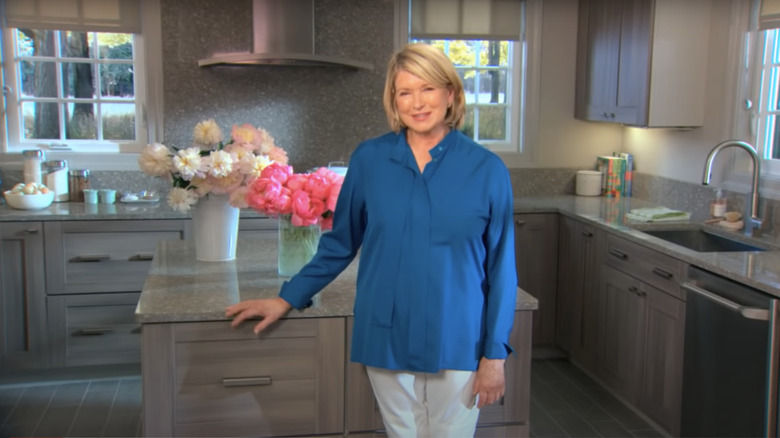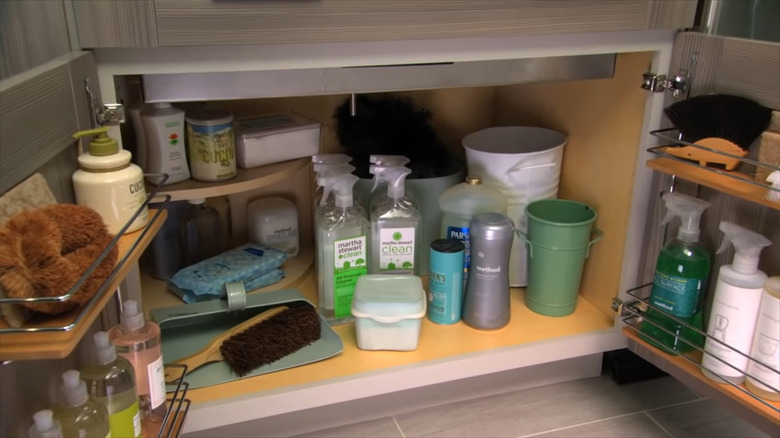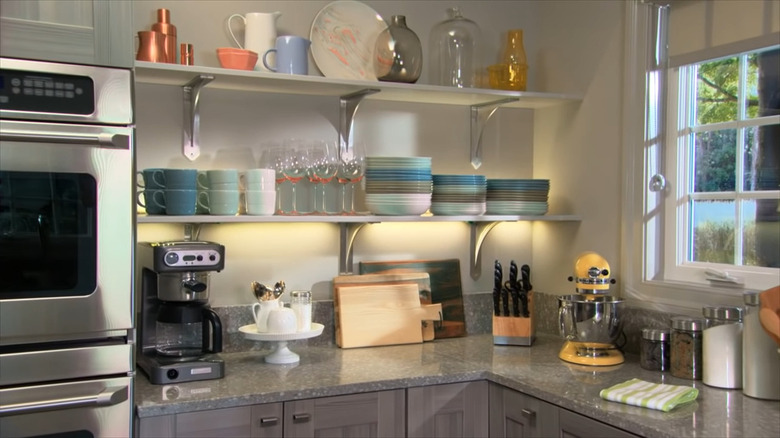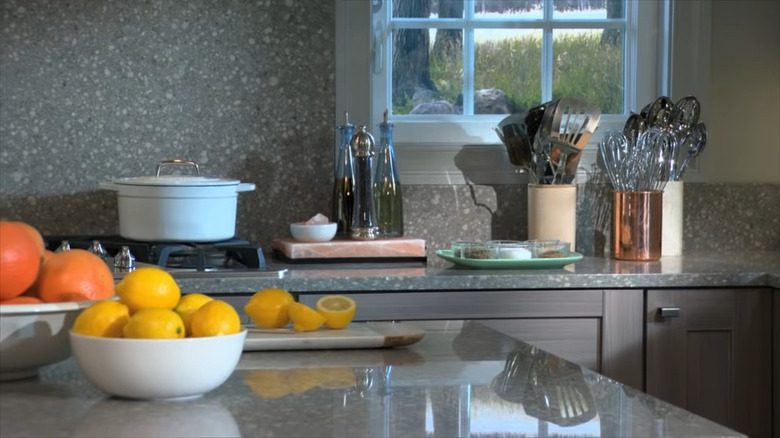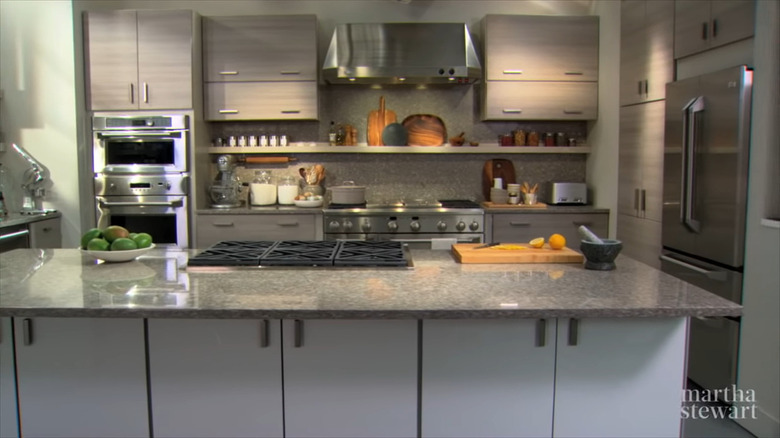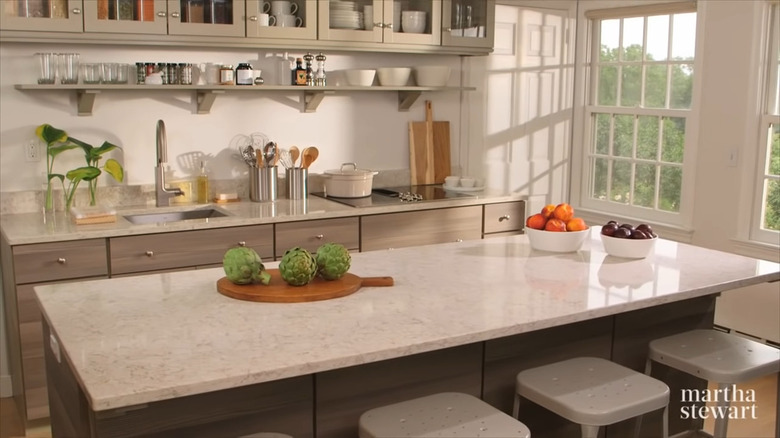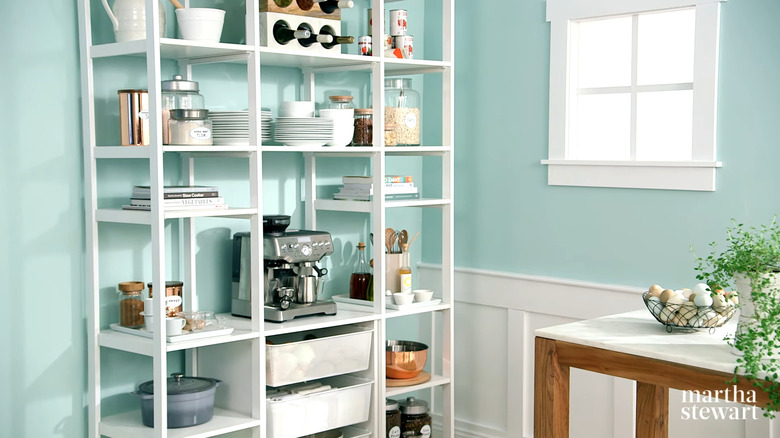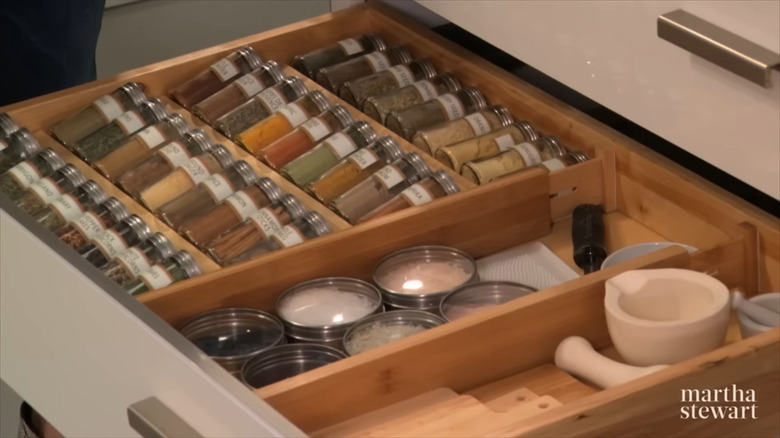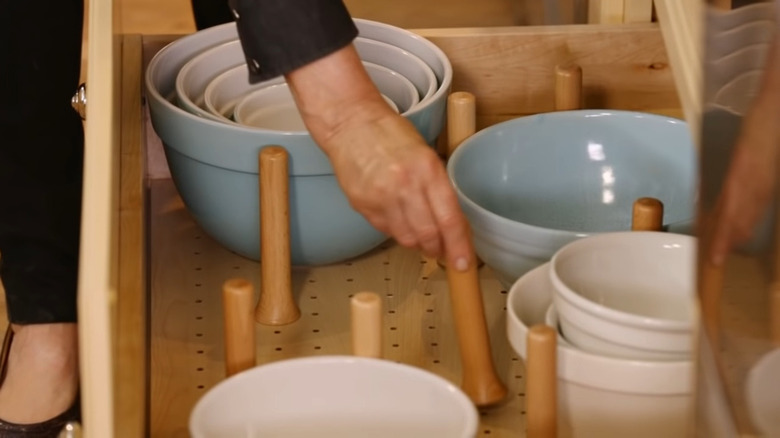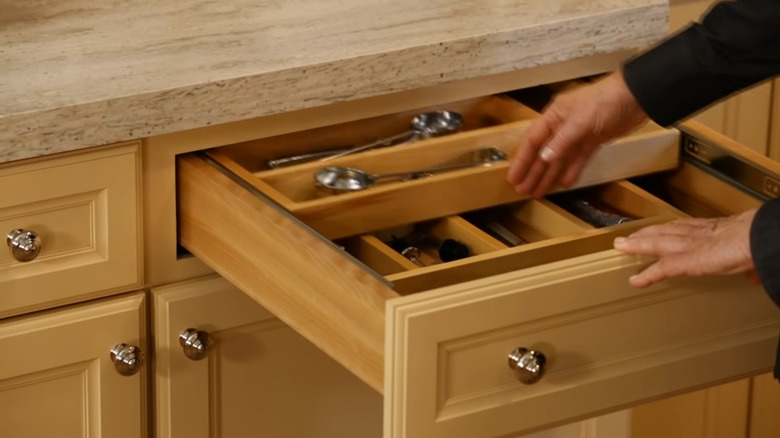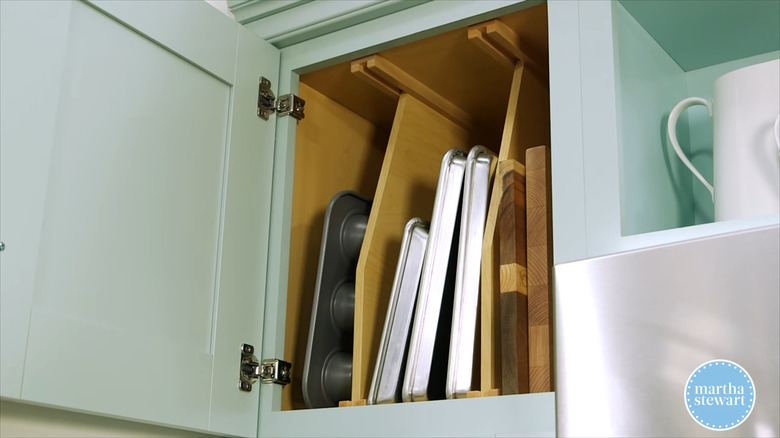Simple Organizing Tips From Martha Stewart To Help Your Kitchen Run More Smoothly
We may receive a commission on purchases made from links.
The key to Martha Stewart's kitchen design success lies in her approach to organization. Fortunately for the rest of us, she shares her tips for creating a kitchen workspace that is both functional and beautiful. One of Stewart's prime organizational rules is to utilize every bit of storage space possible. To do this, she relies on open shelving as well as cabinets, and these storage options extend all the way to the ceiling. Within her kitchen cabinets and drawers, Stewart employs multiple divider systems to organize the spaces for both storage and easy access.
Stewart takes a logical approach to kitchen organization by assembling objects, tools, and utensils according to their function and storing or displaying them in groups. For example, she stores all of her pet supplies together in one cabinet. This includes food, medicine, grooming tools, and pet toys. Stewart carries this organizational principle throughout her kitchen designs. Consequently, baking supplies are stored together in a drawer, pots and pans occupy a different space, and small utensils are separated into groups and stored vertically in containers next to the stovetop. Follow these organizing tips from Martha Stewart to create an efficient kitchen space that runs smoothly.
Keep like items together
The concept of storing similar items together in a defined location is a basic principle of organization in any room of the house. For most of us, the kitchen is the hub of functionality for our homes. When we embark on any task or project, it's crucial to have the necessary tools, ingredients, and products at our fingertips. Whether we're cleaning, cooking, or prepping food, the project runs more smoothly when we can easily find everything that's needed to complete the job. On the contrary, it's a frustrating waste of time when we have to hunt through cabinets and drawers to find the items we need.
That's why Martha Stewart adheres to the rule of storing like items together. For example, she stores her pots and pans (including their lids) together in a large drawer located under the stovetop. That way, she always knows where to look for a cooking vessel, and the items are close to the stove where she will use them.
Based on this principle, Stewart keeps her coffee cups on a shelf above the coffee maker and her mixing bowls in a drawer underneath the counter where she preps food. When cleaning day comes around, she looks no further than the one lower cabinet where she stashes all of her cleaning products, brushes, buckets, and sponges. Once you organize your own kitchen along the lines of Stewart's maxim to group similar items in your storage spaces, you'll find that you accomplish chores more easily.
Store everyday items at eye level
When objects are stored at eye level, we can see them and access them without any effort. Think of the available storage spaces in your kitchen. You probably have upper cabinets or shelves as well as lower cabinets and drawers. Perhaps you even have a pantry with shelving and doors. Every storage area is a piece of valuable real estate that you'll want to maximize to make your kitchen run smoothly, and keeping some items at eye level is one way to do so.
Now, think about the kitchen items that you use on a daily basis (perhaps several times a day). Those items should occupy the prime spots where you can see them and reach them most easily. In Martha Stewart's kitchen, everyday items are neatly grouped and displayed at eye level on countertops and open shelving. The coffee maker, mugs, dinner plates, wine glasses, knives, and cutting boards all occupy the open, eye-level spaces in her kitchen. By contrast, seldom-used pieces of glassware and pottery occupy the top shelf where they serve a decorative purpose and can be reached with the help of a step stool.
Some people debate the usefulness of open shelving due to the fact that items collect dust over time as they sit on the shelves. Although this situation may create the need to pre-wash dishes before using them, it's not an issue with the things you use every day. Typically, those hard-working items get washed on a frequent basis.
Store cooking utensils in vertical containers
When you're prepping and cooking your favorite dishes, it's necessary to grab the proper utensils quickly and easily. If the sauce is simmering or the pancakes need to be turned, you don't have time to rummage through a drawer for a spoon or a spatula. To ensure that her cooking tasks run smoothly, Stewart stores utensils vertically in containers that she keeps on the countertop adjacent to the stovetop.
For maximum efficiency, Stewart deposits the utensils in the vertical containers with the handles down and the working parts of the tools visible above the tops of the containers. To enhance the organization, Stewart uses three utensil containers: one for spoons, one for spatulas, and one for wire whisks.
Sturdy, wide-mouth crocks and cylindrical containers make excellent repositories for cooking utensils in your kitchen work area. For example, this marble utensil crock from Sur La Table is a stylish addition to your countertop. Alternatively, you can use a heavy ceramic pitcher or a wide-mouth vase to store cooking utensils in an upright position. Be sure that the container you choose is heavy enough to hold the utensils without tipping over.
Create storage space up high
To achieve maximum organization, Stewart advocates using every available storage space in your kitchen. One way to do this is to think vertically. Although you'll want to keep everyday items in easy-to-reach spaces, you can stash seldom-used dishes and equipment in high places. Install cabinets or shelving all the way to the ceiling, and you'll find new places to organize and store kitchen items.
For example, the space above the refrigerator goes unused in many kitchens. But Stewart transforms this dead space into storage space with cabinets mounted up high. This is an optimal solution for storing serving dishes and items that you only bring out for holiday celebrations or infrequent dinner parties.
When you use high spaces in your kitchen for storage, it frees up the lower areas for things that you need to access more frequently. However, you should be aware of the fall risk involved in using a step stool to retrieve items from high cabinets and shelves. You'll want to ensure that there is someone in your home who can accomplish this task safely.
Install a shallow shelf above the stovetop
Stewart is a master of food preparation, cooking, and hosting dinners for family and friends. It's no wonder that she organizes her kitchen for maximum efficiency. A shallow shelf running along the wall above the stove and food prep area is an example of the simple and ingenious features that make Stewart's kitchen run smoothly.
The shallow shelf is installed 22 inches above the sink, countertop, and stove top. It protrudes only a few inches from the wall, leaving plenty of room for manipulating pots, pans, and kitchen equipment. The shelf is painted in a color that matches the cabinets, and simple corbels lend a decorative touch.
On the shelf, Stewart keeps cruets of cooking oils, salt and pepper grinders, frequently used spices, small mixing bowls, and water glasses. The things on the shelf are within easy reach when she's cooking and preparing food. By displaying the small, commonly used items on the shelf, Stewart frees up space in the cabinets and drawers to store less-used condiments and dishware as well as large pieces of cookware.
No built-in pantry? Use open shelves
If you don't have a walk-in pantry in your home, kitchen organization can be a challenge. Fortunately, Martha Stewart offers an attractive and functional solution with her pantry storage system. She partnered with California Closets to design this open, modular shelving unit that can be configured to suit your individual needs. Use this unit or a similar one to turn any blank wall into a pantry.
First, select the number of shelving sections you need to fit your wall width and to create enough storage space. In Stewart's pantry system, you can choose your shelves in either 14-inch or 20-inch depths and adjust them to desired heights. Then, you can add wire mesh drawers that slide on tracks installed in the shelving units.
Stewart advocates open shelving to keep food and kitchen supplies visible. On her modular pantry shelves, dishes occupy eye-level shelves, and a coffee maker sits in an easy-to-reach, central position. Stewart fills the shelves with dry goods like oatmeal and sugar stored in large, clear, glass jars. The wire mesh drawers hold vegetables, cloth napkins, and bowls. She keeps pet food in clear glass containers on the lower shelves and positions seldom-used items on the top shelves.
Use drawer dividers to organize multiple like items
Even after you've mastered Stewart's organizational principle of storing similar objects together, you might need additional help to put the contents of your drawers in order. Rather than having a jumble of loose items tossed into a drawer, you can increase your kitchen's efficiency by dividing each drawer into sections for specific contents.
Stewart uses slanted shelves inside a drawer to store multiple jars of spices. She recommends this type of storage because spices stay fresh over long periods of time when they are stored away from sunlight. The angle of the shelves facilitates easy reading of the spice labels when the drawer is opened.
The spice drawer is not the only place where Stewart uses drawer organizers. One drawer is divided in half to keep cloth placemats on one side and cloth napkins on the other side. A knife drawer features dividers to separate the different types of knives as well as cork receptacles that keep the knives from sliding around and banging into each other inside the drawer. Additionally, Stewart's drawer for cooking utensils is neatly organized with dividers installed on the diagonal axis. This arrangement creates long and short sections to accommodate utensils of various sizes.
Install a peg board to organize dishes in drawers
In the kitchens that Martha Stewart designs for The Home Depot, she includes innovative ideas for organizing multiple pieces of cookware and dishware. One surprising detail is a pegboard installed horizontally in the bottom of a large, deep drawer. Several removable pegs fit into the pegboard, creating vertical impediments to keep things from sliding around inside the drawer. The system is completely customizable for endless variations of drawer contents.
Wide and deep drawers make excellent storage areas for serving dishes, mixing bowls, and cookware. You can access the equipment more easily from a pullout drawer than from a cabinet. The problem with this type of storage is that when you open and close the drawer, the contents can shift. Glass, porcelain, and ceramic items may crack or chip due to sliding into each other within the drawer.
To alleviate this problem, Stewart's system with the pegboard and pegs keeps the items separated. The pegs can be removed completely, and you may use only as many pegs as you need. When you re-organize your kitchen, you can change the arrangement of pegs within a drawer to accommodate a different set of cookware or dishware pieces.
Double up on flatware storage trays
Flatware (AKA silverware) consists of the knives, forks, and spoons that we use on a daily basis for eating meals. Many kitchens have a flatware drawer with a divided tray that organizes the utensils. But, did you ever think that the drawer is deep enough to house two layers of flatware for dining as well as small utensils for food preparation?
Martha Stewart uses a layered system where two divided flatware-storage trays are stacked within one drawer. In effect, she doubles her available storage space while organizing and separating the flatware. Martha's system operates by sliding on a track installed in the inner sides of the drawer. The upper-level flatware tray slides back to reveal the contents of the lower-level tray.
Even if you don't have a system as sophisticated as Stewart's sliding flatware trays, you can organize your flatware drawer for maximum functionality. For example, VaeFae offers multiple bamboo drawer organizers for knives, flatware, and kitchen utensils.
Use dividers to store trays vertically
Some pieces of kitchen equipment feature awkward shapes and sizes that are difficult to organize and store. These include cookie sheets, shallow baking pans, muffin pans, cutting boards, and serving trays. It's a frustrating task to retrieve these items when they're stored flat in drawers and cabinets. Frequently, they slide around and become a jumbled mess.
The answer to organizing these large, flat pieces of kitchen equipment is to store them vertically, like books on a bookshelf. Then, it's necessary to create barriers that keep them from falling over and crashing into each other.
In Stewart's kitchen, one deep, upper cabinet is set aside for organizing items that are large and relatively flat. It contains vertical dividers that section off the interior cabinet space. Stewart slides the pieces of cookware in between the dividers, and they're conveniently visible as well as neatly organized. To make things even easier, this cabinet is located above the ovens, so the large pans are within easy reach when Stewart is baking or cooking.
